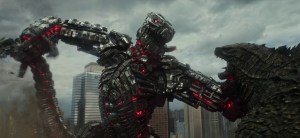The PlayStation 4 still has plenty of life in it before the PlayStation 5 launches this year, but if the console’s new releases ended on June 19th, Naughty Dog’s The Last of Us Part II would be the perfect send-off. It’s an absolute gut-punch of a game built on the established and beloved formula of the original The Last of Us, though things are much more personal this time. It takes some bold steps in deviating from any path you’d ever imagine it taking, but the unexpected directions it turns to fit together neatly once they fall into place. The Last of Us Part II is an engrossing game, and I’m not sure I ever want to play it again.
Videos by ComicBook.com
If other games manage to pull at heartstrings and invoke emotions in players, imagine that pulling escalated to ripping and you’ve got an idea of what you’ll experience in The Last of Us Part II. It’s easy to get choked up in the first few hours, and by the end of the grueling journey across a wasteland of Clickers and brutality, you’ll experience a spectrum of emotions directed at places and people you may not expect them to be aimed at. You’ll love a character in one chapter and despise them in the next as you see what they were, are, and will become.
This all may sound a bit vague and cryptic, but that’s because it’s so difficult to talk about The Last of Us Part II’s story in any pointed way without having to plaster spoiler warnings everywhere. Even then, a shot-for-shot recount of the story wouldn’t do the game justice. Just as the leaks and spoilers plaguing The Last of Us Part II‘s road to launch attempted to give away pivotal moments without context, a secondhand account doesn’t convey the weight of everything that happens.
That weight is felt in nearly everything you do in The Last of Us Part II, and just as you pull away from some characters, you may find yourself repulsed at the idea of performing certain actions. I’m not squeamish by any means when it comes to violence in games – the sickening heft and lethality behind melee attacks and headshots had me seeking out fights in The Last of Us Part II instead of slinking by enemies. Defending myself from a dog using Ellie’s switchblade and hearing its cries afterward is something that stuck with me though. Two times was plenty, and any dog that got into melee range after that meant I’d be taking a quick trip to the “Restart from Checkpoint” option to take out the dog at a distance. That result isn’t much better, but it’s the better of two options. You’ll often find yourself looking for those types of compromises to redeem characters as futile as that may seem at times.
Killing dogs is an easy way to elicit a revolted reaction from someone, but it’s not exactly easy to put down anything else aside from the Infected. Makeshift weapons of violence stick into enemies when you melee them, and seeing someone cower away from a machete after your first cut didn’t yield a clean kill may make you hesitate on that second swing. Shots above the neck occasionally produce a nauseating gurgle and shooting someone in the legs with something more destructive will leave them crawling and looking for help. People scream for their fallen comrades – everyone has names to remind you they’re people, not target practice – and will even get on their knees to ask you to walk away and let them live, but the only viable path is through them, not around.
Throughout several scripted encounters where mandatory actions are required to advance the story, I found myself putting down the controller to see how things played out without my input in case there was something, anything I could do to change course. After a few encounters with the human enemies, you’ll be begging to take on a Clicker or two so that you can at least feel some peace in what you’re doing.
But the savagery of The Last of Us Part II is necessary. Through every remnant of the world you pick through, there are signs of people who were both too violent for their own good and not violent enough to survive. It’s an evil, fundamental truth of The Last of Us Part II’s story meant to unnerve, and though it’s a prerequisite for characters’ well-beings, it’s discomforting how quickly some acclimate themselves to this cruelness.

However you plan on approaching these unforgiving confrontations, The Last of Us Part II‘s refined level design gives you room to experiment and adapt. Grass of varying heights, ledges, and holes in buildings allow players to utilize a verticality system unseen in The Last of Us. Taking someone out with a bow while laying on your back in the tall grass is as satisfying an option as any, and while you won’t be doing deadly leaps in the vein of an Assassin’s Creed from atop a building, something as simple as being able to climb over something and drop in behind an enemy goes a long way in making The Last of Us Part II levels feel more like a playground than a hallway.
Nobody will blame you for reloading checkpoints after you’ve gotten caught if you want to approach a situation differently or want to adhere solely to a stealthy playstyle, but I found reloading checkpoints annoyingly doesn’t put enemies back precisely where you encountered them. Instead, they seem to reset to default starting positions at every checkpoint. It’s simple enough to monitor an enemy’s pathing and dispatch enemies undetected with a bit of patience, so exercise some self-restraint with checkpoints so as not to game the system.
The Last of Us Part II also expanded its world by injecting more open-world aesthetics into the otherwise linear game. This means you’ll be finding more things hidden in nooks in crannies and behind “puzzles” requiring some more complex solutions than just whacking someone with a pipe. Sometimes your reward is something you’ll use throughout your journey while other times it’s a note left by someone who didn’t do so hot during the outbreak. To get the most out of the game, don’t overlook these moments even if it’s just a message scrawled on a fridge. The Last of Us Part II‘s world is a living one full of other people and stories other than the ones laid out in front of you if you look in the right places.
Your AI companions are integral to shaping the world as well through off-handed dialogue, tips, and more ponderous discussions, but they sure do get in the way at times. They’ll sometimes pull off something useful like a stealth takedown alongside you to remind you why it’s worth having them around while other times they just amble about. It’s strange and frustrating to be so methodical in your movements and remain undetected only to have your partner dash in front of an enemy with no consequences, and it doesn’t feel any better to have them hide right next to you and inhibit your movement. It’s the lesser of two evils since the alternative is them exposing you no matter how meticulously you’ve moved, but it doesn’t do much for the immersion.
As impressive as this whole package is when it all comes together, start to finish, it’s an experience I’m not sure I plan to return to anytime soon. Moments and scenes linger in The Last of Us Part II, and even though the game’s the one making you do things, it doesn’t remove any agency from the player or allow you to forget what you did. Themes of darkness and the punishing, cyclical nature of vengeance permeated the buildup to The Last of Us Part II‘s release to the point of being in-your-face and bordering on ostentatious, but they’re wholly indicative of what the game’s about. Playing The Last of Us Part II is an exhausting experience worth stepping away from every now and then to digest what’s happened, and though I may revisit it in the future, the idea of investing time into another draining playthrough immediately after wrapping up the first isn’t exactly a compelling one.
Even though The Last of Us Part II relishes in making players uncomfortable and reminding them characters can lose everything at a moment’s notice, those bleak traits are part of the game’s appeal even if the charm’s a morbid one. It’s a monumental effort in storytelling and a model for tales of vengeance and repercussions pushed forward by gratifying gameplay, and while not everything you do will sit right with you, the game never leads players to believe the result would be anything different.
Rating: 5 out of 5
The Last of Us Part II releases for the PlayStation 4 on June 19th. A review code was provided by the publisher, and the game was reviewed on a PlayStation 4 Pro.









